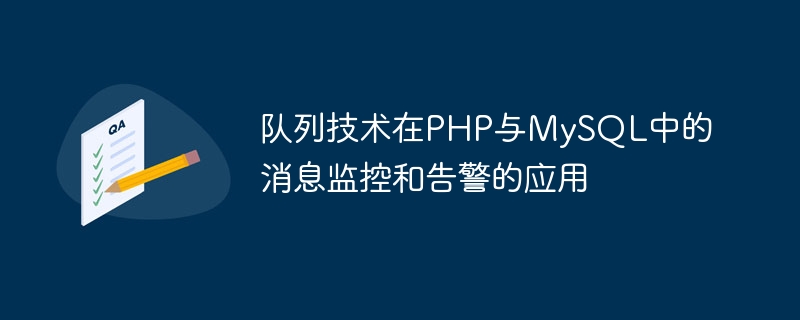

Application of queue technology in message monitoring and alarming in PHP and MySQL
With the rapid development of the Internet, the number of visits to websites and applications is increasing. Users have increasingly higher requirements for website performance and response speed. Most websites and applications need to interact with the database, which makes the performance and stability of the database particularly important. If there is a problem with the database or performance drops, it will have a huge impact on the entire system. Therefore, real-time monitoring and timely alarms have become important tasks for database management.
In PHP and MySQL, queue technology is a common solution that can realize message monitoring and alarming. This article will introduce how to use queue technology to implement message monitoring and alarming in PHP and MySQL, and give specific code examples.
1. Introduction to Queue Technology
Queue technology is a way to execute tasks asynchronously. When a task needs to be executed, it will not be executed directly. Instead, the task will be added to the queue, and the queue will be responsible for execution. This can achieve effects such as decoupling, asynchronousness, and peak clipping, and improve system performance and stability.
2. Requirements for message monitoring and alarming
In PHP and MySQL, the performance and stability of the database are crucial to the normal operation of the system. Therefore, we need to monitor the status of the database in real time and provide timely alarms. The specific requirements are as follows:
3. The process of using queue technology to implement message monitoring and alarming
$redis = new Redis();
$redis->connect('127.0.0.1', 6379);
$redis->select(0);$conn = new mysqli('localhost', 'username', 'password', 'database');
if ($conn->connect_error) {
$error = "数据库连接失败:" . $conn->connect_error;
$redis->rpush('alert_queue', $error);
}$start_time = microtime(true);
$query = "SELECT * FROM tablename";
$result = $conn->query($query);
$end_time = microtime(true);
$elapsed_time = $end_time - $start_time;
if ($elapsed_time > 0.1) {
$error = "查询耗时过长:" . $elapsed_time;
$redis->rpush('alert_queue', $error);
}$output = shell_exec('uptime');
$load = explode("load average:", $output)[1];
$current_load = explode(",", $load)[0];
if ($current_load > 5.0) {
$error = "数据库负载过高:" . $current_load;
$redis->rpush('alert_queue', $error);
}4. Alarm processing
After adding the alarm information to the queue, we can write a consumer script to read the message from the queue and perform alarm processing, such as sending emails, SMS or push to mobile app, etc.
while (true) {
$error = $redis->lpop('alert_queue');
if ($error) {
sendAlert($error); // 发送告警短信
}
sleep(1);
}
function sendAlert($error) {
// 发送告警短信的代码
}5. Summary
Using queue technology to implement message monitoring and alarming in PHP and MySQL can solve the needs of real-time monitoring and timely alarming. By creating a message queue, adding monitoring and alarm messages to the queue, and then processing them through consumer scripts, an efficient and stable message monitoring and alarm system can be realized. This article gives specific code examples, hoping to provide readers with some references in actual development.
The above is the detailed content of Application of queue technology in message monitoring and alarming in PHP and MySQL. For more information, please follow other related articles on the PHP Chinese website!




